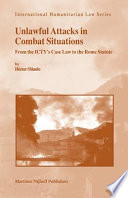
Unlawful Attacks in Combat Situations
By - Olásolo, Héctor
Floor
-
Floor 1
Published
-
Martinus Nijhoff Publishers, Leiden, 2008
ISBN 10 - 9004162003
ISBN 13 - 9789004162006
Book Status
-
1 Qnty Available with us.
Subject
-
International Criminal Court
Shelf No
-
18
Call Number
-
341.6 OLA
Physical Description
-
xix, 288 pages
Notes
-
Include Index